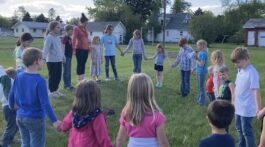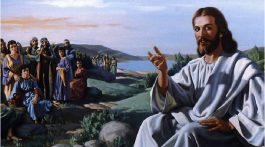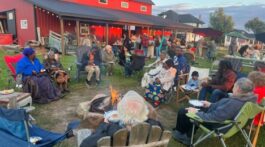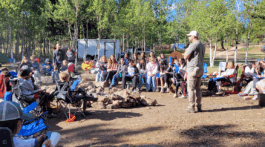Sabbath School Lesson for January 26-February 1, 2019
Overview
Mirroring the seven churches, there are seven seals in Revelation 6 that bind the scroll that was mentioned in Revelation 5. These seals also give us a history of God’s people since the days of the apostle John.
- The first seal, representing Ephesus (the pure, apostolic church), revealed a conquering rider on a white horse. (Sunday)
- The second seal, representing Smyrna (the persecuted, post-apostolic church), revealed a rider on a red horse. (Monday)
- The third seal, representing Pergamos (the church of compromise), revealed by a rider on a black horse. (Monday)
- The fourth seal, representing Thyatira (the corrupt, medieval church), revealed by a rider on a pale horse. (Tuesday)
- The fifth seal, representing Sardis (the church of the Reformation), revealed a cry of martyrs under the altar of God. (Wednesday)
- The sixth and seventh seals, representing Philadelphia (the church of the Great Awakening) and Laodicea (God’s last church), revealed many natural disturbances on earth and signs in the heavens. (Thursday)
Introduction
The visions God gave John to record in the book of Revelation were prophetic in nature, because they represented the story of God’s church that stretched out for many centuries in John’s future. We now see them as fulfilled prophecies, making us even more aware of and thankful for the powerful God we serve.
The best way to condense this enormous time period was for God to reveal it in symbols that were familiar to John, thanks to the sanctuary/temple services that had been so carefully mapped out for Moses and the Israelites on their journey home to Canaan.
Each prophetic picture John receives builds on the information in previous visions. The seven seals provide more details and thus enhance the messages of the seven churches that were first given. They are followed by seven angels with trumpets and then seven plagues that fall on the earth.
These messages, repeated to John in so many different contexts, expand for us the plan of salvation that constitutes the gospel. God wants John, and Christians down through the ages who see these prophecies fulfilled, to be assured and comforted by the news that our final victory over Satan is guaranteed.
Memory Text: ” ‘You are worthy to take the scroll, and to open its seals; for You were slain, and have redeemed us to God by Your blood out of every tribe and tongue and people and nation, and have made us kings and priests to our God; and we shall reign on the earth.’ “ Revelation 5:9, 10 NKJV
After witnessing a magnificent throne room celebration in heaven (chapters 4 and 5), where the Lamb was seen carrying a scroll, John is now shown what each of the seals that bind this scroll contain. Each of the church periods, once again described by John, unlocks for us a portion of the plan for our salvation.
Our unique experience on this earth will one day enable God’s faithful followers to help govern the entire universe of unfallen angels.
Sunday: The Opening of the First Seal
You will notice that as the Lamb opens the first four seals, their contents are announced by one of the four living creatures John described in Revelation 4:6-11. The first living creature may then have been the one described as a lion, an animal of conquest (Revelation 4:7).
John was shown a rider on a white horse, who carried a bow (a symbol of battle and conquest), and was given a crown. The symbols here all point to the conquering victory of Christ. After His resurrection, He was received into heaven, and allowed to enter and minister in the Most Holy Place of God’s heavenly sanctuary. His sacrifice on the cross had been made for our salvation, which symbolically was demonstrated in the outer courtyard on the altar of sacrifice.
The early church in Ephesus, considered pure (white) in character at the beginning, but having lost its first love, is most likely represented by the opening of this first seal that begins to unlock the contents of the scroll.
Discussion Questions:
Read Revelation 6:1, 4:6, 7, Isaiah 6:1, 2, Psalm 99:1, and Exodus 25:22. Who are most likely these four living creatures? What is their purpose in being so close to the throne of God?
Read Revelation 6:2 and 2:1, 2. What makes those in Ephesus so pure and white?
Read Revelation 19:11, 16. Who is this rider on a white horse, and why was He likely the one revealed when they opened the first scroll?
Monday: The Second and Third Seals
Once again, one of the living creatures announced the scene unfolded by opening the second seal. This living creature was said to be like a calf (an animal of sacrifice). A rider on a red horse was seen, and conflict on earth was noted. This would match the bloody persecution that was mounting during the post-apostolic church of Smyrna, when the oppressive measures of the Roman Empire caused so many Christians to sacrifice their lives.
The color black for the horse of the third seal was noted by the next living creature, who had the face of a man (perhaps suggesting Constantine the Great). A famine is suggested by the comments of this living creature. Holding a scale (as used for the weighing of food), the rider symbolically points to the famine of God’s word, and how Bible doctrines were compromised during the church period corresponding to the third church in Pergamos. Black, or darkness, is often used to indicate a lack of the knowledge of the Light of the World, leading to a hungering for Christ, the Living Word.
Discussion Questions:
Read Revelation 6:3, 4 and 2:10. How does the second church period (100-313 A.D.) fit the characteristics of the second seal description?
Read Revelation 6:5, 6 and John 1:5, 9, and 14:6. In what way is Jesus identified with light and truth? What happens to our spiritual senses when we neglect Christ?
Read Revelation 2:14 and Acts 15:29. Why were the decisions of the Jerusalem Council so important to God’s children? How would these restrictions have kept the church spiritually pure?
Tuesday: The Scene of the Fourth Seal
The elements associated with the fourth seal (Revelation 6:7, 8) accurately portray the corrupt church period of the Middle Ages (Thyatira), where God’s church suffered what Jesus may have referred to as “the beginning of sorrows” (Matthew 24:7-9).
- The living creature who announced the fourth seal would have been the one which had the appearance of a flying eagle (a bird of prey).
- The color of this horse was pale, a color of death, when breath leaves the body.
- The name of the rider was “Death”, which may have referred to the many martyrs this era produced.
- This was a powerful entity, ruling over a fourth of the earth through fear, threats, and acts of violence and torture.
Discussion Questions:
Read Revelation 6:7, 8 and Matthew 24:7-9. How does the history of the Middle Ages seem to fit the description of the beginning of sorrows in Matthew 24?
Read Revelation 1:18 and Luke 12:4. What has given martyrs down through the ages the courage to face their trials, even those that led to death?
Describe how the cycle of persecution, compromise, and then more persecution intensifies with each period of church history. Why does this tend to happen?
Wednesday: The Opening of the Fifth Seal
Sardis (or the church of the Protestant Reformation) seems to correspond to the fifth seal. At this time, the persecution focuses on the Reformers and their followers. John hears, upon the opening of the seal, a cry of martyred souls under the altar.
This scene must have reminded him, and other Jewish believers, of the temple ceremony that included the priests pouring some of the blood of the sacrificed animal at the base of the altar (Exodus 29:12 and Leviticus 4:7). Evidently, God, through this symbolic act, has always been aware of blood shed for His cause, and the contribution it has made to spreading the gospel.
Many have used this passage in Revelation to verify the belief that our “souls” go immediately to heaven after death. But upon recalling how God approached Cain with the murder of his brother Abel (“The voice of your brother’s blood cries out to Me from the ground.” Genesis 4:10 NKJV), we can easily see that the blood mentioned under the altar is also used metaphorically, not literally.
Therefore, this verse merely shows us that blood of martyrs is not forgotten by our Father in heaven. He hears their cries, just like he heard the blood of Abel, the first martyr.
Discussion Questions:
Read Revelation 6:9, Exodus 29:12, and Leviticus 4:7. Why did God include this instruction to pour blood at the base of the altar? Why is the blood of martyrs important to the plan of salvation? How does it help vindicate God before the universe?
Read Revelation 6:10 and Zechariah 1:12. How is God’s vengeance an act of mercy?
Read Revelation 6:11, 3:5, and 19:8, and Isaiah 61:10. Where does the righteousness come from that the saints wear as a white robe?
Thursday: The Opening of the Sixth Seal
The sixth and seventh seals are noteworthy because they obviously bring us very close to the end of earth’s history. During these final seals (church periods), many events occurred that Jesus outlined in Matthew 24, when He answered the disciples’ question about the end of the world.
God’s people, during what’s been called the Great Awakening (beginning in the late 1700s and through the 1800s), began to focus on Christ’s Second Coming. As a matter of fact, a growing number of them were convinced that the time was VERY near. Some, prompted by the studies of William Miller, even identified the year 1844 for His Coming (which was the end of the 2300 day prophecy spoken of in Daniel 8:14).
The plan of salvation, portrayed in the sanctuary service, was fast approaching its completion by the time of the sixth and seventh seals (the church periods associated with the churches in Philadelphia and Laodicea).
In the sanctuary, one might first picture the Philadelphia church close to the curtains that divided the Holy Place from the Most Holy Place. The year 1844 (the beginning of the Laodicean period) most likely was the year that Christ, as our High Priest (Hebrews 9:11-12), entered the Most Holy Place of the heavenly sanctuary to begin His final work of redemption, called the cleansing of the sanctuary. See Daniel 8:14.
Christians, who were looking for the Lord’s Advent during the Philadelphia church period, noted that many of the natural disturbances of the sixth seal actually did occur during or close to their time:
- an earthquake of massive proportions in Lisbon (Nov. 1, 1755)
- darkening of the sun and a red moon (May 19, 1780)
- stars falling (Nov. 12, 1833)
These events led to many revivals, and an even more awareness that the time of the end was near. Our world was beginning to show the very signs that Jesus identified in Matthew 24, and people were starting to notice, as they continue to do, even today. The “labor pains” are starting (1 Thessalonians 5:3); the signs have been increasing rapidly ever since.
Discussion Questions:
Read Revelation 6:12-15 and Joel 2:10, 31. Why are these signs given at the end of time? What do they tell us about the condition of our earth, and of God’s care for His followers?
Read Revelation 6:16-17 and Hosea 10:8. Why are the unrighteous so anxious to flee from God on that day?
Read Revelation 6:17 and Malachi 3:2. Who will be able to stand on that day, and why?
And, finally…
Sunday’s lesson this week talked about four judgments (or curses) that would come upon God’s people, if they failed to keep His covenant. They involved the sword, famine, wild beasts, and pestilence.
“For thus says the Lord God: ‘How much more it shall be when I send My four severe judgments on Jerusalem–the sword and famine, and wild beasts and pestilence–to cut off man and beast from it.’ “ Ezekiel 14:21 NKJV
The fourth seal spoke of similar curses when it spoke of a power that would “kill with sword, with hunger, with death, and by the beasts of the earth.” Revelation 6:8 NKJV
We must concentrate on God’s blessings though, which are the opposite of these calamitous circumstances. Remember that God made several promises to His people that are found in Revelation and elsewhere in the Bible. These blessings involve…
- eating from the tree of life and manna (Revelation 2:7, 17)
- not having to experience the second death (Revelation 2:11)
- animals will not hurt us (Isaiah 11:6, 7 and 65:25)
- power over the nations who persecute us (Revelation 2:26)
And if these curses still upset or worry you, keep memorizing Psalm 91. It will keep you calm in the midst of any storm.
“He who dwells in the secret place of the Most High shall abide under the shadow of the Almighty. I will say of the Lord, ‘He is my refuge and my fortress; my God, in Him I will trust.’ Surely He shall deliver you from the snare of the fowler and from the perilous pestilence. He shall cover you with His feathers, and under His wings you shall take refuge; His truth shall be your shield and buckler. You shall not be afraid of the terror by night, nor of the arrow that flies by day, nor of the pestilence that walks in darkness, nor of the destruction that lays wastes at noonday.“ Psalm 91:1-6 NKJV
Next Week’s Lesson: The Sealed People of God
To read the Sabbath School Lesson Quarterly or see more resources for its study, go to https://www.absg.adventist.org/
Other Outlook blogposts by Teresa Thompson, are at http://outlookmag.org/author/teresathompson/










